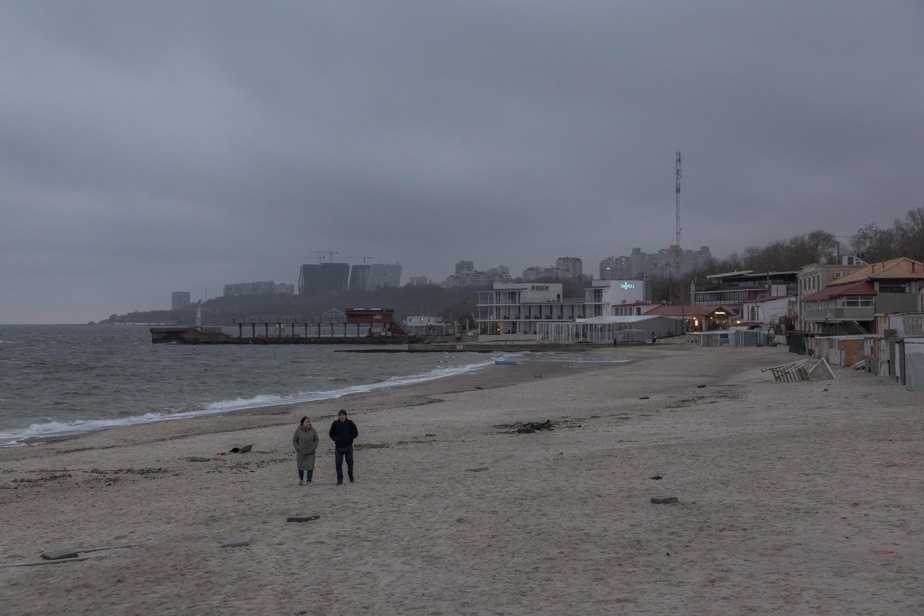(On board a Ukrainian patrol boat in the Black Sea) The Ukrainian patrol boat leaves the port of Odessa on the Black Sea, a regular target of Russian attacks. Standing on the bow, a maritime guard watches the sky, a Stinger missile launcher on his shoulder.
This boat is part of Kyiv’s strategy to push the Russian military fleet away from the Ukrainian coast, the first results of which were praised as a “great victory for Ukraine in the Black Sea” by Volodymyr Zelensky.
On Tuesday, his army claimed a new success in the area by claiming to have destroyed a Russian ship.

PHOTO YORUK ISIK, REUTERS
Russia confirmed on Tuesday that one of its ships, the Novocherkassk (pictured), was damaged in an attack on Kyiv in annexed Crimea.
Despite the supposed superiority of Moscow’s fleet, the Ukrainians managed to keep its ships away from the southwest Black Sea and reopen a maritime corridor to export Ukrainian grain, ignoring Russian threats of bombing.
“This feat is remarkable, because Ukraine is practically devoid of warships,” underlines a recent column published by two American experts on the specialized site DefenseNews.
However, this is Kyiv’s only major military success this year, because after several significant Russian withdrawals in 2022, the front line has remained almost unchanged and in recent weeks Moscow’s troops have further increased pressure on the eastern fronts. and South.
For Ukrainian Navy spokesperson Dmytro Pletentchouk, Russia is now “on the defensive” in the Black Sea unlike “its arrogant presence off the coast of the Odessa region at the start of its invasion” in February 2022 when Moscow had de facto deprived Kyiv of access to the sea.
The patrol boat thus has a key mission: to secure the corridor set up since August between Ukrainian ports in the Odessa region and the Bosphorus Strait, after Moscow slammed the door on an international grain agreement.
Russian “twelve boats” destroyed
The Black Sea represents an essential issue for Ukrainian grain exports, the country being one of the world’s major producers. It is also a strategic issue for Russia.

PHOTO VALENTYN OGIRENKO, REUTERS ARCHIVES
The Black Sea represents a key issue for Ukrainian grain exports.
In the northern part is Crimea, a peninsula annexed by Moscow in 2014 and at the heart of the Russian military system, both to supply the troops occupying southern Ukraine and to carry out strikes to strike deep into Ukraine.
For its part, Kyiv has increased attacks on military installations there, including a spectacular strike against the headquarters of the Russian fleet in Sevastopol, forcing Moscow to move its ships away towards Novorossiysk and Tuapse.
“The weapon that changed the rules of the game was anti-ship missile systems” made by the American Harpoon and the Ukrainian Neptune, both with a range of around 300 kilometers, assures Mr. Pletentchouk to AFP .
According to him, Ukraine has also equipped itself with a new ultra-secret brigade specializing in the use of “marine and underwater” drones which are used for “mining clearance, intelligence and strikes” against Russian targets.
This arsenal has allowed the Ukrainians to destroy “12 Russian boats” and damage 22 others since the start of the invasion, he assures.
“Unique” naval drones
The Ukrainian security services (SBU) told AFP that they had developed “unique” naval drones capable of transporting up to “800 kilograms of explosives 800 kilometers in the conditions of a moderate storm”.

PHOTO BRENDAN HOFFMAN, THE NEW YORK TIMES ARCHIVES
Naval drones designed and operated by Ukrainian military intelligence, which Ukraine says have damaged or sunk dozens of Russian ships.
Called “Sea Baby”, these devices were notably used to strike the bridge linking Crimea to Russia last July and during attacks during which ten Russian boats were hit in October 2022 and 2023, said the SBU.
On the patrol boat of the Ukrainian border guard maritime unit, on board which an AFP team was able to board, the crew spotted through binoculars a first cargo ship that had entered Ukrainian territorial waters after having skirted the coast of Bulgaria and Romania.
Arriving near the ship, Ukrainian border guards prepare to board in combat gear.
Their goal is to “detect weapons, ammunition, explosives” on board, Oleksandr Iakovenko, assistant to the commander of the Odessa detachment of the Maritime Guard, explains to AFP.
Mine danger
Their inspection completed, the men descend from the cargo ship like tightrope walkers, via a small rope ladder, placed directly on the hull and unstable under the effect of the swell.
Since the start of the year, the maritime guard has inspected more than 2,200 vessels, according to Mr. Yakovenko.
A team can do around fifteen per day, “quite difficult and meticulous work” which requires “good physical fitness, endurance” and which is done against a backdrop of permanent risk of Russian attacks, he adds. .
The danger comes from Russian missiles, drones and mines, floating or launched from planes in the grain corridor, notes Mr. Pletentchouk, who deplores the enemy’s domination in the air.
Two civilian cargo ships were slightly damaged by mines in the water but were able to continue their journey, he added. If these incidents did not cause any casualties, “the danger is present,” he said.
The Ukrainian Maritime Guard and the naval forces of the Armed Forces of Ukraine patrol some 200 kilometers of coastline, as well as the ports of Pivdenny, Odessa and Chornomorsk, as well as Izmail and Reni on the Danube, further south.
And despite Russian threats of reprisals against civilian ships circulating in the area and “systematic attacks on port infrastructure”, Ukraine has been able to export “10 million tonnes of products via this corridor by 302 ships to 24 countries” since August, Ukrainian Infrastructure Minister Oleksandr Koubrakov welcomed Tuesday.
